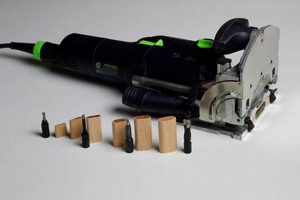The selection of a superior substance designed to minimize friction between moving parts in woodworking equipment constitutes a critical aspect of machinery maintenance. Such products, often oil-based or synthetic, facilitate smoother operation, reduced wear, and extended equipment lifespan. An example includes a high-quality, non-gumming oil applied to the bearings of a table saw to ensure optimal cutting performance.
Employing appropriate lubrication strategies yields multiple benefits. It reduces energy consumption by minimizing frictional losses, prevents premature component failure, and contributes to a safer working environment. Historically, simple oils were used; however, advancements in material science have led to the development of specialized formulations that offer enhanced protection against heat, corrosion, and contaminants. Regular and correct application is vital for the sustained performance of woodworking machinery.
Therefore, a detailed examination of different lubricant types, their specific applications within woodworking machinery, and best practices for their implementation will be presented. This exploration will cover the properties of various options, methods for selecting the right lubricant for particular machines, and schedules for consistent upkeep to maximize the benefits of proper lubrication.
Lubrication Best Practices for Woodworking Machinery
Effective lubrication is paramount for ensuring the longevity and optimal performance of woodworking equipment. The following guidance provides practical advice on selecting and applying lubricants to maximize machine efficiency and minimize wear.
Tip 1: Select Appropriate Lubricant Type: Consider the manufacturer’s recommendations and the specific operating conditions of the machinery. High-speed components may require low-viscosity oils, while heavily loaded parts may benefit from greases with extreme pressure additives.
Tip 2: Establish a Lubrication Schedule: Implement a regular lubrication schedule based on machine usage and environmental factors. Record lubrication activities to track maintenance and identify potential issues proactively.
Tip 3: Apply Lubricant Correctly: Utilize appropriate application methods, such as grease guns, oil cans, or automatic lubrication systems, to ensure adequate coverage and prevent over- or under-lubrication. Avoid contamination by using clean applicators and containers.
Tip 4: Inspect Lubricated Components Regularly: Monitor lubricated components for signs of wear, overheating, or lubricant degradation. Address any issues promptly to prevent further damage and downtime.
Tip 5: Avoid Mixing Lubricant Types: Incompatible lubricants can react and form deposits that impede machine performance. Consult the manufacturer’s guidelines before switching or mixing lubricant types.
Tip 6: Clean Lubrication Points Before Application: Remove dirt, debris, and old lubricant from lubrication points before applying fresh lubricant. This ensures proper adhesion and prevents contamination of the new lubricant.
Tip 7: Store Lubricants Properly: Store lubricants in a cool, dry place away from direct sunlight and potential contaminants. Ensure containers are properly sealed to prevent oxidation and degradation.
Following these recommendations contributes to the reliable and efficient operation of woodworking machinery, reducing maintenance costs and extending equipment lifespan.
With a solid understanding of these best practices, the subsequent sections will delve into specific lubricant types and their applications within the woodworking industry.
1. Viscosity
Viscosity, defined as a fluid’s resistance to flow, is a critical property when determining the optimal lubricant for woodworking machinery. The appropriateness of a lubricant’s viscosity directly impacts its ability to form a protective film between moving parts. If the viscosity is too low, the lubricant film may be insufficient, leading to increased friction, wear, and potential equipment failure. Conversely, excessively high viscosity can cause increased drag, higher energy consumption, and inadequate penetration into tight clearances. For example, a spindle operating at high rotational speeds requires a low-viscosity oil to minimize frictional heating, while a heavily loaded gearbox necessitates a high-viscosity lubricant to withstand extreme pressure and prevent metal-to-metal contact.
The selection of the correct viscosity is often dictated by the specific operating conditions of the woodworking machine. High-speed routers, sanders, and planers typically require oils with lower viscosities to facilitate rapid heat dissipation and efficient lubrication of bearings and other critical components. Equipment operating under high loads or at lower speeds, such as bandsaws or jointers, benefit from higher-viscosity lubricants that maintain a robust film thickness even under extreme pressure. Machinery manufacturers frequently specify a viscosity range for their equipment, and adhering to these recommendations is crucial for ensuring proper lubrication and preventing premature wear.
In summary, viscosity plays a fundamental role in the overall effectiveness of a lubricant in woodworking machinery. Proper viscosity selection ensures adequate lubrication, minimizes friction, reduces energy consumption, and extends equipment lifespan. Deviations from the recommended viscosity range can have detrimental effects, highlighting the importance of careful consideration and adherence to manufacturer guidelines. The challenges associated with incorrect viscosity selection underscore the significance of understanding the relationship between viscosity and the long-term performance of woodworking equipment.
2. Material Compatibility
Material compatibility is paramount when selecting lubricants for woodworking machines. The interaction between the lubricant and the materials within the machinery dictates the lubricant’s long-term effectiveness and the integrity of the equipment itself. An incompatible lubricant can degrade seals, corrode metal components, or swell plastic parts, leading to premature failure and costly repairs.
- Seal and Gasket Degradation
Elastomeric seals and gaskets are used throughout woodworking machinery to prevent leaks and maintain pressure. Certain lubricants can cause these materials to swell, shrink, or harden, leading to loss of sealing ability and subsequent leakage. For instance, mineral oil-based lubricants may degrade natural rubber seals, necessitating the use of synthetic elastomers and compatible synthetic lubricants. Identifying the seal material and selecting a lubricant with documented compatibility is essential to prevent such degradation.
- Metal Corrosion
Woodworking machines incorporate various metal alloys, including steel, aluminum, and brass. Incompatible lubricants can promote corrosion of these metals, particularly in the presence of moisture. Certain additives in lubricants, if not carefully chosen, can accelerate galvanic corrosion between dissimilar metals. Selecting lubricants with appropriate corrosion inhibitors and ensuring compatibility with all metal components in the system minimizes the risk of corrosion and extends the life of the machinery.
- Plastic and Polymer Swelling
Many woodworking machines utilize plastic or polymer components for housings, gears, and bushings. Some lubricants can cause these materials to swell or dissolve, leading to dimensional changes and reduced mechanical strength. For instance, aggressive solvents in certain lubricants may attack polycarbonate or acrylic parts, causing crazing or cracking. Lubricant selection must consider the chemical resistance of the plastic and polymer components to avoid this type of degradation.
- Wood Contamination
The contamination of wood by incompatible lubricants can lead to staining, discoloration, or altered finishing characteristics. This is especially crucial in applications where the wood comes into direct contact with lubricated parts, such as feed rollers or conveyor systems. Selecting lubricants with low volatility and non-staining properties, or implementing effective sealing mechanisms, minimizes the risk of wood contamination and maintains the quality of the finished product.
Considering these facets of material compatibility is crucial in choosing the appropriate substance. Optimizing this aspect of lubricant selection contributes to prolonged equipment life, reduced maintenance, and consistent performance of woodworking machinery.
3. Temperature Resistance
Temperature resistance, in the context of lubricants for woodworking machines, refers to the ability of a lubricant to maintain its desired properties across a range of operating temperatures. Elevated temperatures can cause lubricants to thin, leading to reduced film strength and increased wear. Conversely, low temperatures can increase viscosity, hindering flow and potentially starving components of necessary lubrication. The selection of a lubricant with suitable temperature resistance is, therefore, paramount for ensuring consistent and reliable machine performance.
Consider the example of a high-speed router operating in a woodworking shop during the summer months. The router bearings generate heat, and the ambient temperature further elevates the operating temperature. A lubricant with inadequate temperature resistance would thin excessively, leading to increased friction, potential bearing failure, and reduced router lifespan. Conversely, a woodworking machine stored in an unheated shop during winter requires a lubricant that remains fluid enough to provide adequate lubrication upon start-up, preventing cold-start wear. The appropriate temperature resistance ensures optimum performance in various environmental conditions, which is why it’s a significant factor.
In summary, temperature resistance is an important factor to consider when determining the selection of lubricants for woodworking machinery. Proper evaluation of the operating environment and the thermal properties of the lubricant is vital for achieving optimum lubrication, minimizing wear, and maximizing the lifespan of woodworking equipment. Ignoring temperature considerations can result in premature component failure and increased maintenance costs.
4. Rust Inhibition
Rust inhibition is a critical property in selecting the best lubricant for woodworking machines. The operating environments of these machines often involve exposure to moisture, either from the ambient air, water-based finishes, or cleaning processes. This moisture, combined with the presence of iron and steel components, creates conditions conducive to rust formation. Rust, or iron oxide, is a corrosive byproduct that weakens metal structures, increases friction, and can lead to machine failure. Therefore, lubricants formulated with rust inhibitors are essential for protecting vulnerable machine parts.
The inclusion of effective rust inhibitors within a lubricant formulation is not merely an added benefit, but a fundamental requirement for long-term machine health. These inhibitors work by forming a protective barrier on metal surfaces, preventing moisture and oxygen from directly contacting the metal. This protective layer can be created through various mechanisms, such as the formation of a hydrophobic film or the neutralization of corrosive acids that promote rust. For example, in a bandsaw, the blade guides and table surface are susceptible to rust. A lubricant with robust rust inhibition will safeguard these components, ensuring smooth blade movement and preventing material contamination from rust particles.
Ultimately, the presence of effective rust inhibitors directly contributes to the extended operational life and consistent performance of woodworking machines. Without adequate rust protection, even the highest quality mechanical components are at risk of degradation, resulting in increased maintenance, costly repairs, and potential downtime. Therefore, when selecting a lubricant, rigorous attention must be paid to its rust inhibition capabilities, assessed through industry-standard testing and real-world application performance. Prioritizing this attribute ensures that the lubricant actively protects against corrosion, contributing significantly to the longevity and reliability of woodworking equipment.
5. Application Method
The efficacy of any substance intended as the “best lubricant for woodworking machines” is intrinsically linked to its method of application. The incorrect application of even the most superior lubricant can negate its benefits, leading to inadequate protection and potential equipment damage. The method must ensure the lubricant reaches all critical friction points in the correct quantity, without causing contamination or material incompatibility. A high-viscosity grease designed for a gearbox, if applied sparingly with a brush instead of forced into the assembly with a grease gun, may not adequately coat gears, resulting in premature wear. Conversely, a low-viscosity oil meant for precision bearings, if over-applied, can attract dust and debris, accelerating abrasive wear. The method and the material become intrinsically intertwined, rendering the correct technique an indispensable component of effective lubrication.
Practical examples underscore the significance of this connection. Automatic lubrication systems, often found on larger industrial woodworking machines, deliver precise doses of lubricant at predetermined intervals, minimizing human error and ensuring consistent coverage. However, these systems require careful maintenance and calibration to prevent over- or under-lubrication. In contrast, simpler machines often rely on manual application. For instance, applying oil to a table saw’s trunnion mechanism with a precision oiler allows for controlled distribution, preventing overspray onto the saw table and reducing the risk of contaminating wood stock. The selection of the appropriate application tool and technique depends on the machine’s design, operating conditions, and the lubricant’s properties, each factor impacting the overall effectiveness of the maintenance procedure.
In summary, the selection of an appropriate application method is not merely a procedural detail but a crucial determinant in achieving optimal lubrication of woodworking machines. It directly influences the lubricant’s ability to protect against wear, reduce friction, and extend equipment lifespan. Understanding the specific requirements of each machine, the characteristics of the lubricant, and the capabilities of various application tools is essential for ensuring the “best lubricant” delivers its intended performance. The challenge lies in adopting a holistic approach that integrates lubricant selection, application technique, and regular maintenance to maximize the benefits and minimize the risks associated with lubrication in woodworking environments.
Frequently Asked Questions About Lubricants for Woodworking Machinery
This section addresses common inquiries regarding the selection and application of lubricants for woodworking machines. The information provided aims to clarify best practices and dispel misconceptions related to equipment maintenance.
Question 1: What are the primary factors influencing lubricant selection for woodworking machinery?
Several key considerations guide lubricant selection. These include the machine’s operating speed, load, temperature, and environmental conditions. Additionally, material compatibility and manufacturer recommendations should be rigorously assessed.
Question 2: How often should woodworking machinery be lubricated?
Lubrication frequency varies based on machine usage and manufacturer specifications. A regular lubrication schedule, informed by these factors, is vital. More frequent lubrication may be necessary for machines operating under heavy loads or in dusty environments.
Question 3: Is it acceptable to use general-purpose lubricants on woodworking machines?
General-purpose lubricants may not provide adequate protection for specialized woodworking machinery. Specific lubricants formulated for the operating conditions and materials found in woodworking applications are generally recommended.
Question 4: What are the potential consequences of over-lubricating woodworking machinery?
Over-lubrication can lead to lubricant leakage, attracting dust and debris. This contamination can accelerate wear and reduce machine efficiency. Moreover, excess lubricant can damage seals and other components.
Question 5: How does temperature affect the performance of lubricants in woodworking machinery?
Temperature significantly influences lubricant viscosity. High temperatures can reduce viscosity, leading to inadequate film strength. Low temperatures can increase viscosity, hindering flow and causing start-up wear. Selecting lubricants with appropriate temperature resistance is crucial.
Question 6: What are the benefits of using synthetic lubricants compared to mineral oil-based lubricants in woodworking machines?
Synthetic lubricants often offer enhanced thermal stability, oxidation resistance, and load-carrying capacity compared to mineral oil-based lubricants. They may also provide improved protection against wear and corrosion, particularly in demanding operating conditions.
Proper lubricant selection, application, and maintenance are critical for preserving the functionality and longevity of woodworking machinery. Adhering to best practices and addressing common questions contributes to efficient and reliable equipment operation.
The following section provides a summary of the key points discussed in this article, emphasizing the importance of selecting the best lubricant and proper maintenance practices.
Conclusion
The comprehensive evaluation of lubricant properties, application methods, and maintenance strategies underscores the critical role of selecting the best lubricant for woodworking machines. Factors such as viscosity, material compatibility, temperature resistance, and rust inhibition significantly impact machine performance and longevity. Diligent consideration of these aspects, combined with adherence to manufacturer guidelines and best practices, is essential for ensuring optimal equipment operation and minimizing costly repairs.
In the continuous pursuit of operational efficiency and equipment reliability, proactive engagement with appropriate lubrication protocols remains paramount. The implementation of well-informed maintenance practices not only safeguards valuable woodworking machinery but also contributes to a safer and more productive working environment. The ongoing commitment to superior lubrication standards will undoubtedly yield tangible benefits in the form of extended equipment lifespan, reduced downtime, and enhanced overall operational effectiveness.



![Robland X31: The Ultimate Woodworking Machine [Review] Step-by-Step Guides, Tools & Inspiration to Build Beautiful Wooden Decor on a Budget Robland X31: The Ultimate Woodworking Machine [Review] | Step-by-Step Guides, Tools & Inspiration to Build Beautiful Wooden Decor on a Budget](https://woodfromhome.com/wp-content/uploads/2025/11/th-702-300x200.jpg)



